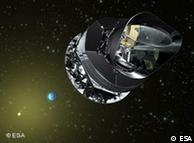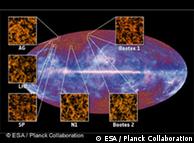The Planck
satellite, launched in 2009 by the European Space Agency to study cosmic
microwave background radiation, has yielded a number of new
astronomical finds, European astronomers said Tuesday.
Deployed 1.5 million
kilometers (937,000 miles) from Earth, the spacecraft has provided
evidence for a hidden group of galaxies billions of light-years away
that spawned stars at a much faster rate than what is observed today.
"What happens is that
in dusty galaxies, you have a stars forming, [and they go through] a lot
of their life shrouded by dust, within the galaxy that you're looking
at," David Clements, a physics lecturer at Imperial College London, told
Deutsche Welle.
 The Planck space observatory launched in 2009
The Planck space observatory launched in 2009
By using the Planck
satellite, scientists are able to use that dust, which "re-processes"
the star's energy and shoots it out again as infrared energy, he added.
Other telescopes, like
the Hubble Space Telescope, are only looking at star formation by
examining optical - or visible - light. By using traditional optical
telescopes, scientists can only see about half of the total energy
output of the universe's stellar phenomena.
"It's a direct way of
counting out the evolution of galaxies in this missing half," he said.
"You can fill in the hidden history of the universe, because there's
this amount of energy coming out of the dust, there's a bunch of star
formation happening, which you can't see in the optical."
Planck can detect "cold
dust," or dust particles with a temperature of approximately 20 degrees
Kelvin, or -243 degrees Celsius. The satellite has found over 900 such
clumps in the Earth's own Milky Way galaxy, which represent the first
stages of stellar development.
Planck also reveals galaxy clusters
 These first six fields are used to detect and study the Cosmic Infrared Background.
These first six fields are used to detect and study the Cosmic Infrared Background.
Among other results,
the spacecraft also collected an entire new set of data on galaxy
clusters, or large groups of thousands of galaxies, which help
astrophysicists determine the shape, nature, volume and evolution of the
universe.
This team's next data
release from Planck is scheduled for January 2013, which will describe
cosmic microwave background in unprecedented detail, and hopes to shed
some light on the very early stages of the universe.
"We're proud to be
playing a key role in this amazing discovery machine," David Parker,
director of space science and exploration for the UK Space Agency, said
in a statement.
"These new results are
all vital pieces of a jigsaw that could give us a full picture of the
evolution of both our own cosmic backyard - the Milky Way galaxy that we
live in - as well as the early history of the whole universe."
Author: Cyrus Farivar
Editor: Sean Sinico









